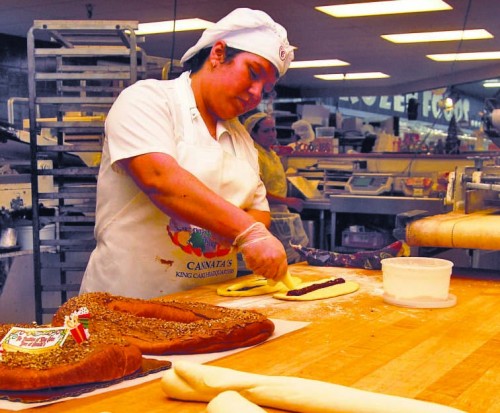
Wilbert Joseph Dupre Sr.
January 7, 2012
The one that got away
January 10, 2012More than two weeks before the official kick-off to Mardi Gras’s ancillary season, many south Louisiana bakeries were already bronzing dough, glazing icing and dusting king cakes with tri-colored sprinkles.
Although it might seem like an early start for king cake production, that’s far from true. The lines that once governed the bakeries have been trivialized, the beginning and end of the season now running full circle through the region’s ovens.
“It’s a big business,” said Joni Cannata Blakeman, co-owner of Cannata’s Family Markets. “Let me just put it that way.”
King’s Day, or the Day of Epiphany, is annually recognized as the 6th of January. For Christians, it marks the day the Three Wise Men ended their trek and discovered infant Jesus.
The king cake has long been a medium to honor the religious lore, with a symbolic plastic baby stuffed inside for gorging teeth to find. Historically, Jan. 6, also known as “Twelfth Night,” has ushered in the sales of king cake.
But just as the production of king cake has evolved to a point where it’s no longer commonplace for bakeries to stash the baby inside the bread, the kick-off date has also lost its significance as the big business has shifted to year-round production to keep up with demand.
The business is particularly large at Cannata’s, which ships “thousands and thousands and thousands,” of king cakes by FedEx each year. Some of the cakes make it as far as London or Iraq, but most scatter throughout the United States, addressed to transplanted Louisianans or adopters of Mardi Gras customs.
“It’s more than 10,000,” Blakeman said. “We’re in all these peoples’ houses now. Cannatas has been in a lot of houses that they wouldn’t have normally been in and it’s because there was demand for king cakes, Mardi Gras.”
Aside from random orders filled for the craving public, local bakeries have devised seasonal features such as Chris Cringle or Easter king cakes. Of course, a south Louisiana business wouldn’t be complete without LSU- and Saints-styled products to satisfy the football-loving masses.
Although the business operates for 12 months, January does usher in the peak of king cake baking. “They get Mardi Gras fever,” said Melissa Bertinot, co-owner of Best Bakery.
Once the festival season begins churning, the ovens’ fires are rarely extinguished.
For day parades, Best Bakery will produce between 100 and 120 king cakes per day. When the parades roll at night, that number is doubled. “We can’t even answer the phone,” Bertinot said.
Best Bakery found its niche in its dough, a recipe conceived in the early 1900s and passed down through each of the bakery’s iterations.
Called Chix-de-Femme, or “Bun of a Woman,” the cinnamon-and-sugar spiraled dough has become synonymous with the Houma bakery located on Tunnel Boulevard. The yellow dough is topped by request.
Seasonal offerings include candy canes, Easter eggs, Independence Day odes and Valentine’s Day hearts. The most-popular Mardi Gras purchase is archetypal in its oval shape but split half and half with tri-colored sprinkles and caramel pecan glaze; Bavarian cream filling is used more often than not.
The strangest request? One that was jet black in honor of an over-the-hill birthday. Or, maybe, it was the king-cake wedding cake. The largest? A cake with a 134-foot circumference, baked for a local hospital.
Best Bakery began shipping cakes out of town last year, but the bulk of its orders are local.
At Cannata’s, king cakes are made entirely from scratch in a bakery that operates 24 hours per day during the Mardi Gras peak. The filling is baked into the bread instead of being injected after the bronzing, which gives the cakes more moisture, Blakeman said.
Cannata’s fundamental king-cake-baking principles were established two decades ago when the market entered the festival fray and began developing its recipe. Devising a suitable composition tested patience.
“We went all over New Orleans and we got a king cake from everywhere (to sample),” Blakeman said. “The techs were about to put me in an oven and bake me. They called me the ‘Goldilocks of King Cakes’ because I was like, ‘This one’s too hard,’ and ‘This one’s too soft,’ but we finally got something that tasted really good.
“We made our mistakes, but I think we’ve gained a good reputation from our king cakes and we want to keep it there.”
The grocery store is also unique in the variety of dough flavors and fillings it offers.
Chocolate dough is a relative newcomer to the menu, joining red velvet and more than 60 fillings. The glut of potential combinations includes candy apple, creole praline and chocolate devotion.
“The simpler the better, the (Keep It Simple, Stupid) method, but naturally we wanted to make sure they had their choices of what they got,” said Blakeman, who has to increase her workforce threefold when the bakery transitions to 24-hour production. “We developed a computer program that helps us with production. We have to break down and package all of these cakes. It grew through the years”








